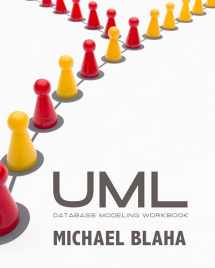
UML Database Modeling Workbook
ISBN-13:
9781935504511
ISBN-10:
1935504517
Edition:
First Edition
Author:
Michael Blaha
Publication date:
2013
Publisher:
Technics Publications, LLC
Format:
Paperback
220 pages
FREE US shipping
on ALL non-marketplace orders
Marketplace
from $33.16
USD
Marketplace offers
Seller
Condition
Note
Seller
Condition
New
Brand New! Not overstocks! Brand New direct from the publisher! Ships in sturdy cardboard packaging.
Book details
ISBN-13:
9781935504511
ISBN-10:
1935504517
Edition:
First Edition
Author:
Michael Blaha
Publication date:
2013
Publisher:
Technics Publications, LLC
Format:
Paperback
220 pages
Summary
UML Database Modeling Workbook (ISBN-13: 9781935504511 and ISBN-10: 1935504517), written by authors
Michael Blaha, was published by Technics Publications, LLC in 2013.
With an overall rating of 4.3 stars, it's a notable title among other
books. You can easily purchase or rent UML Database Modeling Workbook (Paperback) from BooksRun,
along with many other new and used
books
and textbooks.
And, if you're looking to sell your copy, our current buyback offer is $0.3.
Description
With our appetites for data on the rise, it has become more important than ever to use UML (Unified Modeling Language) to capture and precisely represent all of these data requirements. Learn how to construct UML data models by working through a series of exercises and self-assessment tests. Beginners can learn the UML directly. Experienced modelers can leverage their understanding of existing database notations, as the book extensively compares the UML to traditional data modeling (Information Engineering).
- Discover a new way of representing data requirements and communicating better with your business customers.
- Understand what UML constructs mean and how to properly use them.
- Learn subtleties of the UML. Become a power UML developer.
- Practice constructing data models with the exercises. The back of the book answers every exercise.
- Assess your mastery of the material. Each part has a multiple-choice test that can quantify your understanding.
- Improve your ability to abstract - think about different ways of representation - as you construct data models.
- Measure the quality of your data models.
- Be able to create database designs (DDL code) starting from a UML data model.
- Be able to write SQL database queries using a data model as a blueprint.
- Know the differences among operational models, data warehouse models, enterprise models, and master models. They are all aspects of data modeling.


We would LOVE it if you could help us and other readers by reviewing the book
Book review

Congratulations! We have received your book review.
{user}
{createdAt}
by {truncated_author}


